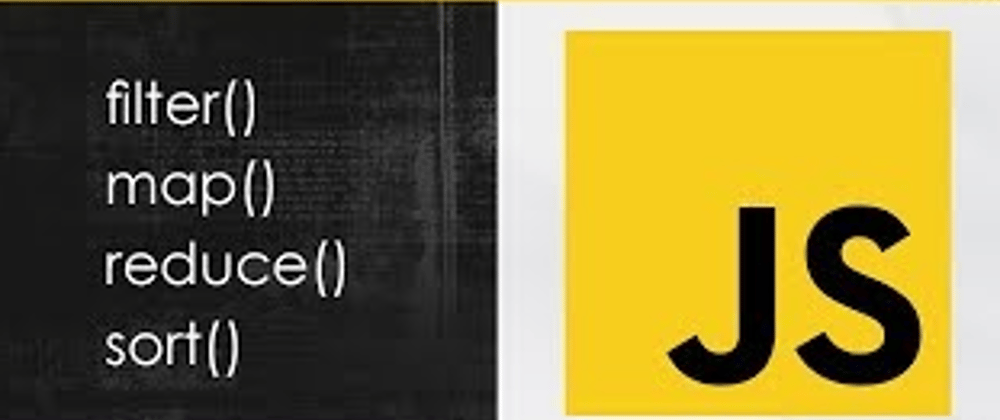Functions are a very important part of JavaScript, and you will use them all the time. In JavaScript, functions are first-class objects, because they can have properties and methods just like any other object. There are several ways to define functions, the most common one is to define functions with a function declaration. Example:
function calcRectArea(width, height) {
return width * height;
}
console.log(calcRectArea(5, 6));
//-------> Output: 30
Term "callback"
When we pass a function expression (an anonymous function) or the pointer (variable name, declared function name) to a function as an argument, the passed function is called a callback. Since the receiving function will execute, or call that function at a later time; that is, it will call it back, it is called a callback.
Let's learn more about Array methods: Filter, Map, Reduce, and Sort
Arrays provide a lot of methods. JavaScript already has methods built into its Array data type. Follows the examples of how to use it.
Use .filter() to filter an Array
filter() returns a new array of filter elements that meet a certain condition. The filter() method creates a new array with all elements that pass the test implemented by the provided function.
filter() does not execute the function for array elements without values and doesn't change the original array.
Syntax:
array.filter(function(currentValue, index, arr), thisValue)
function(currentValue, index,arr) is required.
A function to be run for each element in the array, function arguments are:
currentValue- required, the value of the current element
index - optional, the array index of the current element
arr - optional, the array object the current element belongs to.
thisValue- optional. A value to be passed to the function to be used as its "this" value. If this parameter is empty, the value "undefined" will be passed as its "this" value.
Example
const words = ['spray', 'limit', 'elite', 'exuberant', 'destruction', 'present'];
const result = words.filter(word => word.length > 6);
console.log(result);
//-------> Output: Array ["exuberant", "destruction", "present"]
//-------> Output: ["exuberant", "destruction", "present"]
Example:
[10, 20, 30, 40].filter(function() {
return true;
}) //=> [10, 20, 30, 40] (map, basically)
[10, 20, 30, 40].filter(function(e) {
return e < 30;
}) //=> [10, 20]
[10, 20, 30, 40].filter(function(e, index) {
return index % 2 === 0;
}) //=> [10, 30] (elements with an even-numbered index)
Example:
const myArray = [
{ id: 1, name: "Mark" },
{ id: 2, name: "Sam" },
{ id: 3, name: "Sandy" },
{ id: 4, name: "Mark" },
]
myArray.filter(element => element.name === "Mark")
//-------> Output : 0:{id: 1, name: "Mark"},
// 1:{id: 4, name: "Mark"}
Use .map() to transform an Array
The map() method calls a callback function on every element of an array and returns a new array that contains the results.
The map() method takes two named arguments, the first one is required whereas the second one is optional.
Syntax:
const newArr = oldArr.map(function(currentValue, index, array) {
// Do stuff with currentValue (index and array are optional)
});
newArr - the new array that is returned
oldArr - the old array being operated on. This array will not be changed
currentValue - the current value being processed
index - the current index of the value being processed
array - the original array
Example:
const array1 = [1, 4, 9, 16];
// pass a function to map
const map1 = array1.map(x => x * 2);
console.log(map1);
//-------> Output: [2, 8, 18, 32]
Example:
[10, 20, 30, 40].map(function(a) {
return a * 2;
});
//-------> Output: [20, 40, 60, 80]
ES6 Example:
const arr = [1, 2, 3, 4];
const newArray = arr.map(element => {
return element * 2;
});
const newArrayOneLiner = arr.map(element => element * 2);
console.log(arr); // [1, 2, 3, 4]
console.log(newArray); // [2, 4, 6, 8]
console.log(newArrayOneLiner); // [2, 4, 6, 8]
Use .reduce() to reduce an Array to a value
The reduce() method executes a reducer function (that you provide) on each element of the array, resulting in a single output value. The reduce() method executes a provided function for each value of the array (from left-to-right).

The return value of the function is stored in an accumulator (result/total).
Note: reduce() does not execute the function for array elements without values.
This method does not change the original array.
Syntax:
array.reduce( function(total, currentValue, currentIndex, arr),
initialValue )
This method accepts five parameters:
function(total, currentValue, index, arr): It is the required parameter and used to run for each element of the array. It contains four-parameter which are listed below:
total: It is a required parameter and used to specify the initialValue, or the previously returned value of the function.
currentValue: It is a required parameter and used to specify the value of the current element.
currentIndex: It is an optional parameter and used to specify the array index of the current element.
arr: It is an optional parameter and used to specify the array object the current element belongs to.
initialValue: It is an optional parameter and used to specify the value to be passed to the function as the initial value.
[10, 20, 30, 40].reduce(function(memo, i) { return memo + i }) //=> 100
[10, 20, 30, 40].reduce(function(memo, i) { return memo + i }, 100) //=> 200
Example
Subtract the numbers in the array, starting from the beginning:
var numbers = [125, 20, 25, 30];
document.getElementById("demo").innerHTML = numbers.reduce(myFunc);
function myFunc(total, num) {
return total - num;
}
//=> 50
Let's see how .reduce() works. The callback would be invoked four times, with the arguments and return values in each call being as follows:
[0, 1, 2, 3, 4].reduce(function(accumulator, currentValue, currentIndex, array) {
return accumulator + currentValue
})
| callback iteration | accumulator | currentValue | currentIndex | array | returnValue |
|---|---|---|---|---|---|
| first call | 0 | 1 | 1 | [0, 1, 2, 3, 4] | 1 |
| second call | 1 | 2 | 2 | [0, 1, 2, 3, 4] | 3 |
| third call | 3 | 3 | 3 | [0, 1, 2, 3, 4] | 6 |
| fourth call | 6 | 4 | 4 | [0, 1, 2, 3, 4] | 10 |
Use sort()
The sort() method sorts the elements of an array in place and returns the sorted array.
Syntax
arr.sort([compareFunction])
Paramaters:
compareFunction is optional. It specifies a function that defines the sort order.
firstEl, the first element for comparison.
secondEl, the second element for comparison.
To sort an array of objects by the values of the object’s properties, you use the sort() method and provide a comparison function that determines the order of objects.
Example
Suppose that you have an array of students objects as follows:
let students = [
{
firstName: 'Johnny',
lastName: 'Lee',
age: 20,
},
{
firstName: 'Anna',
lastName: 'Zax',
age: 19,
},
{
firstName: 'Zion',
lastName: 'Sanches',
age: 22,
}
];
The following statement snippet sorts the students array by ages in ascending order:
students.sort((a, b) => {
return a.age - b.age;
});
where to display the students, you can use the forEach() method:
studetns.forEach((e) => {
console.log(`${e.firstName} ${e.lastName} ${e.age}`);
});
Output:
Anna Zax 19
Jonny Lee 20
Zion Sanchez 22
To sort the students by ages in descending order, you just need to reverse the order in the comparison function like this:
students.sort((a, b) => b.age - a.age);
students.forEach((e) => {
console.log(`${e.firstName} ${e.lastName} ${e.age}`);
});
output:
Zion Sanchez 22
Jonny Lee 20
Anna Zax 19
Conclusion
We saw how map(), filter(), reduce() and sort() can ease the life of a developer by reducing the number of unnecessary explicit loops and empty array declarations. Try replacing your for loops with these state-of-the-art functions whenever you get a chance. More documentation can be found here.
To connect please check my Github, LinkedIn or Twitter.
Thank you for reading!








Oldest comments (4)
Very nicely explained. Good work!
A post on Javascript closure and call back would be of great help.
Thank you @arvindsridharan !
Very nice and clear article, thanks Ivana.
Are you using the JavaScript Markdown syntax highlight in all of your code snippets? It looks like they are not rendered as JavaScript snippets but as plain text from my side of view.
Otherwise, one thing I would like to add about this infamous
Array.prototype.reducemethod is that it can be used as a base to create all of theArray.prototype.*goodies you have talked about and even theeveryorsomemethods.thx a lot!